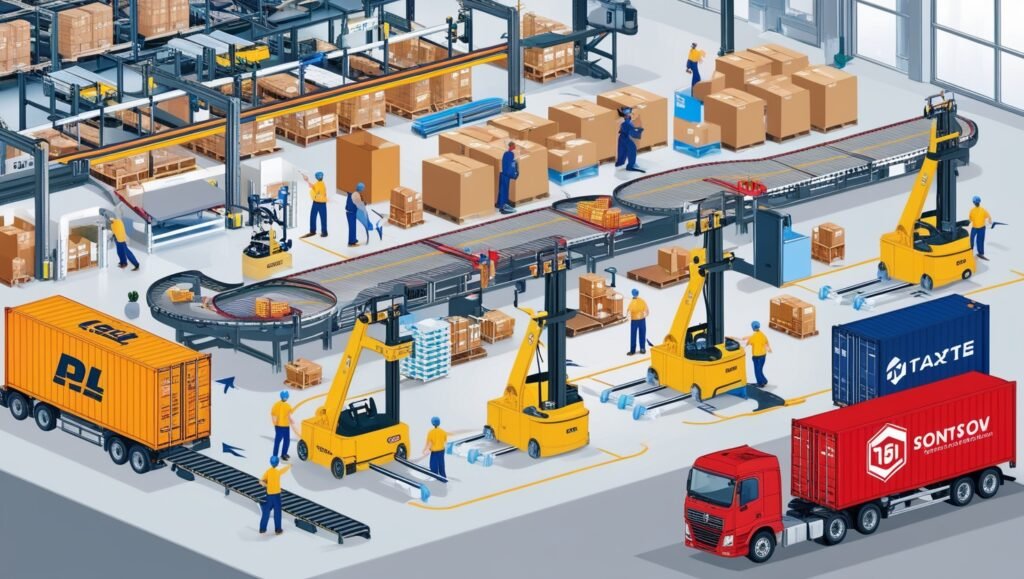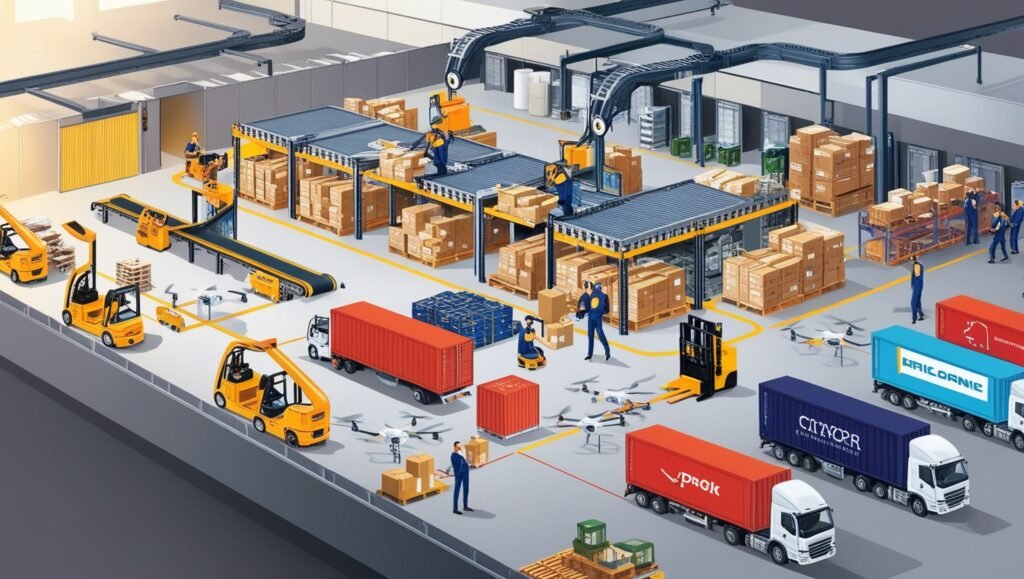- Introduction
- Understanding 3PL Warehousing
- Innovations Driving 3PL Warehousing
- Future Trends in 3PL Warehousing
- Conclusion
- Frequently Asked Questions:
- What does 3PL mean?
- What is 3PL warehousing?
- What are the main benefits of using 3PL warehousing?
- How does 3PL warehousing save costs for businesses?
- Can 3PL warehousing help businesses expand internationally?
- What role does automation play in 3PL warehousing?
- How is AI used in 3PL warehousing?
- What is the Internet of Things (IoT) and how is it applied in 3PL warehousing?
- How can blockchain technology impact 3PL warehousing?
- What are collaborative robots (cobots), and how are they used in warehouses?
- What is hyperlocal warehousing?
- How do 3PL providers handle inventory management?
- Can 3PL warehousing accommodate seasonal fluctuations in demand?
- Which industries benefit the most from 3PL warehousing?
- What should businesses consider when choosing a 3PL provider?
- How do businesses ensure data security when working with a 3PL provider?
- What are common contract terms with a 3PL provider?
Introduction
The world of logistics and supply chain management is rapidly evolving, driven by technological advancements and changing consumer expectations. Among the various facets of this domain, third-party logistics (3PL) warehousing stands out as a critical component that enables businesses to streamline their operations, increase efficiency, and scale effectively. This blog discusses the intricacies of 3PL warehousing, exploring its benefits, innovations, and future trends.

Understanding 3PL Warehousing
These 3PL warehousing involves in outsourcing warehousing and distribution services to specialized third-party providers. These providers handle various logistics functions such as storage, inventory management, order fulfillment, and transportation. By leveraging the expertise and infrastructure of 3PL providers, businesses can focus on their core competencies while ensuring that their products reach customers efficiently. Benefits of 3PL Warehousing
Cost Efficiency: One of the primary benefits of 3PL warehousing is cost savings. Businesses can avoid the significant capital expenditure required to build and maintain their own warehouse facilities. Instead, they pay for the services they use, which can be scaled up or down based on demand. This flexibility helps manage costs more effectively.
Expertise and Technology: 3PL providers invest in the latest technologies and employ logistics experts to optimize warehousing operations. This includes advanced inventory management systems, automated picking and packing solutions, and sophisticated tracking mechanisms. Such investments enable businesses to benefit from cutting-edge solutions without having to develop them in-house.
Scalability and Flexibility: 3PL warehousing offers the ability to scale up operations according to market demand. Whether it’s a seasonal surge in orders or expansion into new markets, 3PL providers can quickly adjust their services to meet changing needs. This flexibility is crucial for businesses aiming to stay agile in a competitive landscape. Geographic reach: Many 3PL providers have a global presence, allowing businesses to expand their reach without the logistical challenges of setting up new facilities. This is especially beneficial for e-commerce companies looking to enter international markets.

Innovations Driving 3PL Warehousing
Automation and Robotics: The integration of automation and robotics is revolutionizing 3PL warehousing. Automated guided vehicles (AGVs), robotic picking systems, and conveyor belts are increasing efficiency and reducing labor costs. These technologies enable faster order processing and reduce errors, thereby improving customer satisfaction.
Artificial Intelligence and Machine Learning: AI and machine learning algorithms are being used to predict demand, optimize inventory levels, and enhance route planning. By analyzing vast amounts of data, these technologies provide information that helps 3PL providers make informed decisions, resulting in better resource utilization and cost savings.
Internet of Things (IoT): IoT devices are being used to monitor warehouse conditions, track assets, and ensure the integrity of goods. Sensors can provide real-time data on temperature, humidity, and location, which is especially important for industries such as pharmaceuticals and food, where product quality is paramount.
Sustainable practices: With the growing emphasis on sustainability, 3PL providers are adopting environmentally friendly practices. This includes using energy-efficient lighting, optimizing transportation routes to reduce carbon emissions, and implementing recycling programs. Sustainable warehousing not only benefits the environment but also enhances a company’s reputation among environmentally conscious consumers.

Future Trends in 3PL Warehousing
Blockchain technology: Blockchain has the potential to revolutionize supply chain transparency and security. By providing an undeniable ledger of transactions, blockchain can enhance traceability, reduce fraud, and improve trust among supply chain partners.
Augmented Reality (AR): AR is set to play a key role in training warehouse staff, optimizing picking processes, and improving warehouse layout planning. AR glasses can provide real-time information and guidance, which can increase efficiency and reduce training time.
Collaborative robots (cobots): Unlike traditional industrial robots, cobots are designed to work alongside human workers. They can assist with repetitive tasks, reducing physical stress on employees, and improving overall productivity.
Hyperlocal warehousing: The rise of e-commerce and the demand for faster delivery times are driving the trend toward hyperlocal warehousing. These smaller, strategically located warehouses enable faster order fulfillment, meeting the expectations of consumers demanding same-day or next-day delivery.
Conclusion
The 3PL warehousing is a dynamic and essential component of modern supply chain management. By leveraging the expertise, technology, and infrastructure of 3PL providers, businesses can achieve significant cost savings, operational efficiency, and scalability. As innovations such as automation, AI, IoT, and blockchain continue to shape the industry, 3PL warehousing will play a vital role in meeting the evolving demands of the global marketplace. Embracing these advancements and staying abreast of emerging trends will be critical for businesses looking to succeed in the competitive world of logistics and supply chain management.
Frequently Asked Questions:
What does 3PL mean?
3PL stands for third-party logistics. It means outsourcing logistics and supply chain management functions to specialized service providers.
What is 3PL warehousing?
This 3PL warehousing involves outsourcing storage, inventory management, order fulfillment, and distribution services to third-party providers. These providers handle warehousing operations on behalf of businesses.
What are the main benefits of using 3PL warehousing?
The primary benefits include cost efficiency, access to expertise and advanced technology, scalability, flexibility, and increased geographic reach.
How does 3PL warehousing save costs for businesses?
By outsourcing warehousing functions, businesses avoid the capital expenditures required to build and maintain their own warehouse facilities. They pay for the services they use, which can be scaled according to demand.
Can 3PL warehousing help businesses expand internationally?
Yes, many 3PL providers have a global presence, enabling businesses to expand their reach without the logistical challenges of setting up new facilities in different countries.
What role does automation play in 3PL warehousing?
Automation increases efficiency, reduces labor costs, and speeds up order processing by using automated guided vehicles (AGVs), robotic picking systems, and conveyor belts.
How is AI used in 3PL warehousing?
AI and machine learning algorithms predict demand, optimize inventory levels, and enhance route planning by analyzing large amounts of data, leading to better resource utilization and cost savings.
What is the Internet of Things (IoT) and how is it applied in 3PL warehousing?
IoT involves using sensors and connected devices to monitor warehouse conditions, track assets, and ensure product integrity. Real-time data on temperature, humidity, and location is especially important for sensitive items.
How can blockchain technology impact 3PL warehousing?
Blockchain can enhance supply chain transparency and security by providing an immutable ledger of transactions, improving traceability, reducing fraud, and building trust between partners.
What are collaborative robots (cobots), and how are they used in warehouses?
Cobots are designed to work alongside human workers, assisting with repetitive tasks, reducing physical strain, and improving overall productivity.
What is hyperlocal warehousing?
Hyperlocal warehousing involves smaller, strategically located warehouses that enable faster order fulfillment, meeting the demand for faster delivery times such as same-day or next-day delivery.
How do 3PL providers handle inventory management?
3PL providers use advanced inventory management systems to track stock levels, manage orders, and optimize storage space, ensuring efficient and accurate inventory control.
Can 3PL warehousing accommodate seasonal fluctuations in demand?
Yes, 3PL warehousing offers scalability and flexibility, allowing businesses to adjust their warehousing needs based on seasonal demand fluctuations.
Which industries benefit the most from 3PL warehousing?
E-commerce, retail, pharmaceuticals, and food and beverage industries are among those that benefit significantly from 3PL warehousing due to the need for efficient logistics and distribution.
What should businesses consider when choosing a 3PL provider?
Key considerations include the provider’s experience, technical capabilities, geographic reach, scalability, and range of services offered. It is also important to evaluate their track record and customer reviews.
How do businesses ensure data security when working with a 3PL provider?
Businesses should ensure that the 3PL provider has strong data security measures in place, including encryption, secure access controls, and regular security audits.
What are common contract terms with a 3PL provider?
Contract terms can vary, but they typically include service level agreements (SLAs), pricing structures, duration, and termination clauses. It is important to clearly define expectations and responsibilities in the contract.
